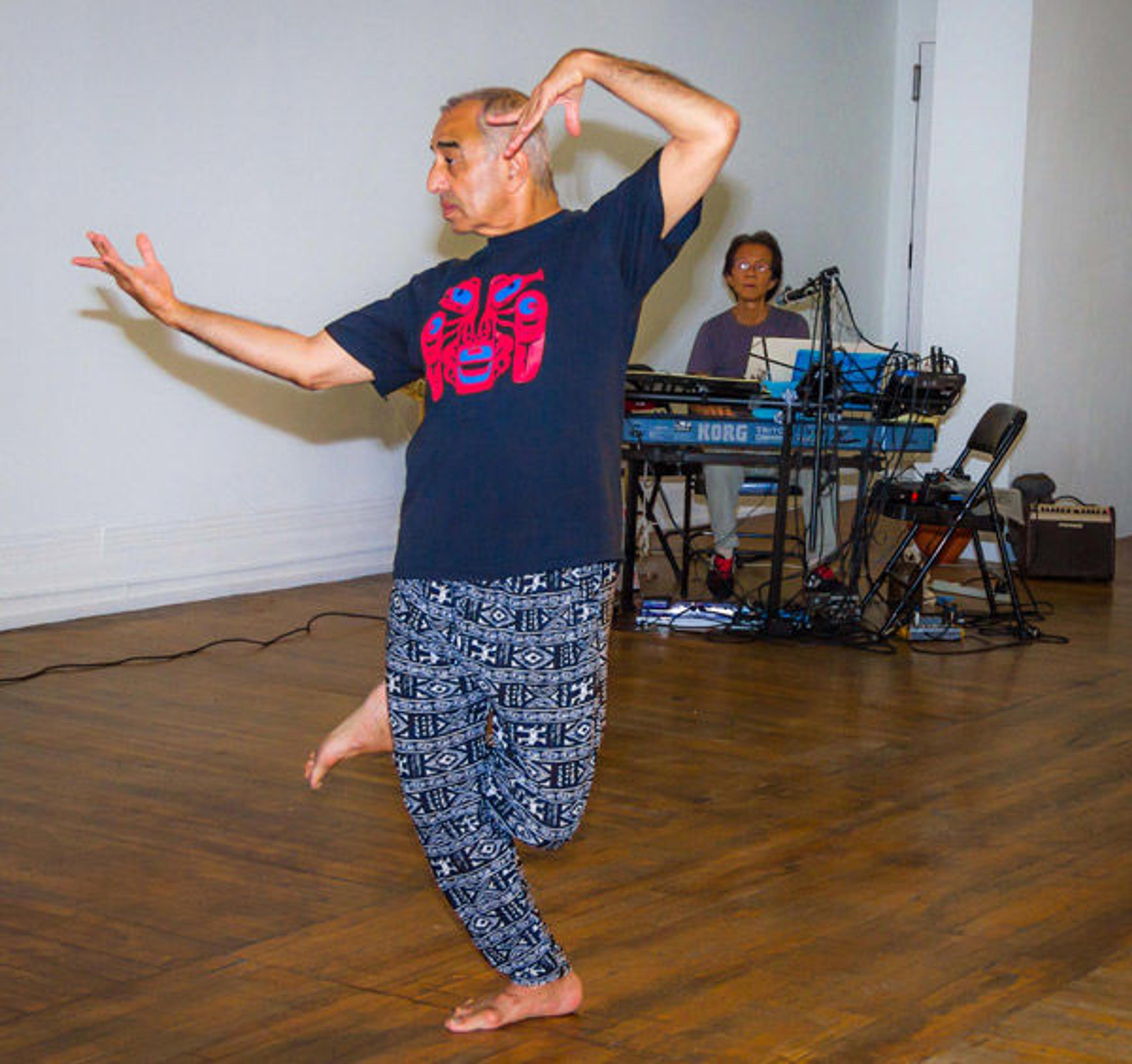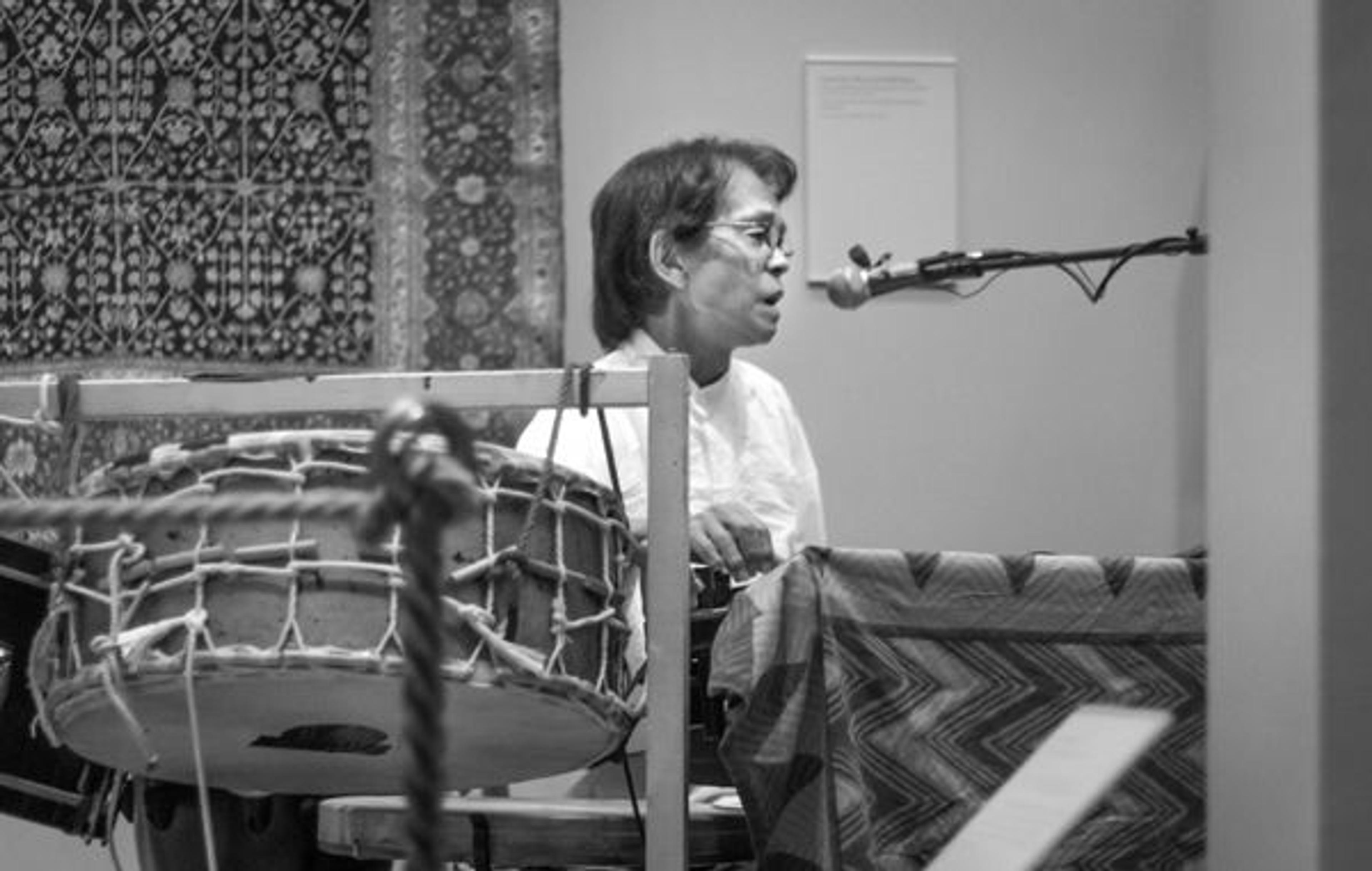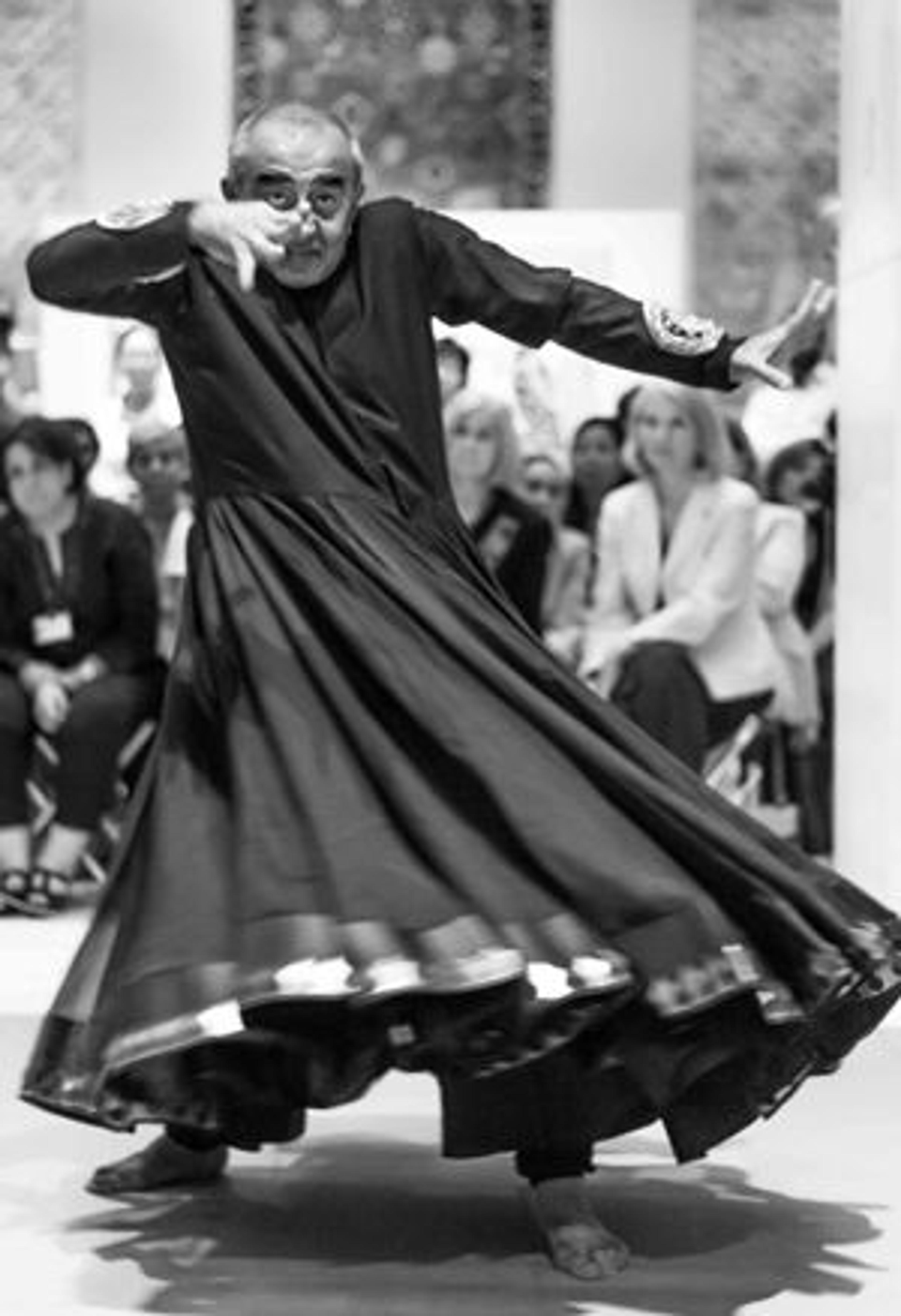
Astad Deboo performs Eternal Embrace in gallery 463 as part of the Moroccan Court Music Series. All photos by Amit Kumar
«As its name implies, the Moroccan Court Music Series has traditionally taken place in the Met's Patti Cadby Birch Court, and has showcased the talents of musicians and vocalists as they perform music from the Middle East and South Asia. The performance on September 18 not only took place in a new space (gallery 463, devoted to the art of Mughal South Asia), but also introduced a new art form to the series: dance. In this performance, Astad Deboo, a pioneer of contemporary Indian dance, collaborated with New York–based musician Yukio Tsuji to present the world premiere of Eternal Embrace. The piece, inspired by the work of Sufi poet Hazrat Bulleh Shah, was choreographed specifically for this gallery concert. While the event was in its early planning stages, I sat down with Astad and Yukio to gain some insight into their work both as individual performers and as artistic collaborators.»
Julia Rooney: Please briefly describe your training in music and dance. Which traditions do each of you come from?
Astad Deboo: My training initially started in the Indian classical dance technique. First I studied Kathak and, later on, Kathakali. My study of Kathakali was basically to have more dance vocabulary available to me, because by then I had branched into creating work under the contemporary umbrella. Having traveled and studied in the West and the East, I spent time observing and studying various dance techniques—Martha Graham, Jose Limón, etc.—but all of these experiences were just short courses to familiarize myself and to see whether these dance techniques really suited my body. Through the years, I have evolved a style which is distinctively my own but still stems a lot from the Indian classical dance tradition. It's like a jigsaw puzzle being fit together to make a picture.
Yukio Tsuji: I have no education in music. I was initially a singer, and then I began to play everything—country, western, jazz, folk song—as a self-taught musician. When I was eighteen or nineteen years old, I went to a university to take a foreign training course because I thought I was going to become a regular working person. However, I was already playing with a professional group and making more money than I would outside of music.
Julia Rooney: So a lot of your training and education has come from experience, from just playing?
Yukio Tsuji: Yes, by playing. Also the La MaMa Experimental Theatre Club was like a school for me. I could develop my own experiments in many ways by performing for La MaMa's productions.
Julia Rooney: On that note, Astad: In working with companies or commissioners, have you felt liberty in developing your own practice? Or has the voice of the company you're working with strongly dictated what you do?
Astad Deboo: In my case, most of my work is my own. I am the artistic director and I bring in various collaborators to work with, so I have a vision of what I'm looking at or creating. The few times I have worked with other directors or choreographers, there is a dialogue which permits both of us to have a bit of freedom to give in the process of creation. I bring in various performers from northeastern India, in Manipur, and while I have a fair knowledge, I'm not so much of an expert. So sometimes there's nothing wrong in asking. After all, you want the work to stand out, and others can give you inputs to make the work better. So I don't work with an ego coming in. I want to use the traditions of other performers to help me in my choreography.

Astad Deboo and Yukio Tsuji in rehearsal
Julia Rooney: Eternal Embrace is based on the poem "Maati." What is your relationship to narrative and thematic content? Do your pieces have the arc of a story line, or can they become nonlinear?
Astad Deboo: They are nonlinear. The essence of "Maati" is related to mortality, death, and suffering. So I will be working with those themes, but we are not going word-for-word off the poem. Eternal Embrace is leading me into another direction of more Sufi-based music. My work has a lot of spirituality and a lot of emotions that are very much a part of my creativity. The fact that I am trained in Indian classical dance makes the rasas (emotions) very important, but at the same time there is a lot of work I have done that is abstract.
Julia Rooney: Was Eternal Embrace in any way site-specific—choreographed with the knowledge that you'd be performing in the galleries of the Met? I know there are certain constraints when working in a museum as opposed to a performance venue. I'm wondering how the space impacts your thinking about producing a work, or even the momentary decisions you make.
Astad Deboo: I've danced in lots of spaces, museums, galleries, and done a lot of site-specific work. The space here at the Met is very restrictive, but this has not bothered me. In fact, it challenges me, and challenge is always good. If I had a larger space, more lights, or even set pieces such as a pool of water or a bamboo background, the work would have a completely different look. But the real core of the performance will be there.
Julia Rooney: Work often comes out of constraint, and constraint can sometimes make work more interesting. Yukio, you've done work scoring films, but also plenty of live performance and accompaniment. How are these contexts, live versus recorded, different for you?
Yukio Tsuji: Most of the time they're all the same. When I write film scores, I usually hear music by looking at the scene and, within the structure of limitation, I improvise or write the music that works. In the end, it is always myself that comes out in the music. But I feel more comfortable playing outdoors; I think I can open up more in that environment.

Yukio Tsuji during the performance of Eternal Embrace
Julia Rooney: Are there also ideal spaces for you, Astad? You have such nuanced facial expressions and subtlety in your gestures that I wonder if there is an ideal way that you like your audience to be positioned or an ideal lighting, given the nature of your work.
Astad Deboo: I like my audiences to be intimate. I don't have to be programmed in a two-thousand-seat auditorium, though I have done many performances at that scale. The entrances and exits will have to be looked into, but the choreography will stay the same. The choreography doesn't change as far as spaces go, especially when you've choreographed for other people. This is the world premiere of Eternal Embrace at the Met, but it could be performed in a different space in the future.
Julia Rooney: Your performances captivate audiences in the moment of watching and listening to them. Beyond this, what do you see the larger impact of your work in the arts to be? What value do you see your work having in communities beyond the world of entertainment and the arts?
Left: Astad Deboo during the September Moroccan Court Music Series performance

Astad Deboo: For over twenty years, I have been working with a deaf community, with street children in an area of India. There's a lot of talent in these communities and one can help protect their talent by using oneself as a catalyst or artistic director. I talk from an Indian perspective, since we have a lot of talent but very little funding and support. The luxury of receiving grants and commissions, such as those that exist in this country and many other parts of the world, is something we don't have in India, and that's a challenge.
I was trying to create an umbrella of contemporary dance to stand on its own, which was nonexistent in India in the late 1970s. Even some who wanted to come could not—they would be banned by their guru, and the art form would be looked upon as sacrilegious. But now the scenario has changed completely and every classical dancer wants to be contemporary, so I started just wanting to share my work. I knew of a deaf theater company in Calcutta. The artistic director asked me to do a workshop, and it started off the journey. I don't have a school, but I mentor various groups of individual performers, bring them to a standard, and then let them go in the different directions they want to explore.
Yukio Tsuji: My intention is to become a sort of channel for people to open themselves to another dimension. We are all connected, but we tend to not think of this. I can connect them to a different dimension through feeling. It is very easy for me to do that through music.
Julia Rooney: Your work allows for a way of life and a way of being in the world.
Astad Deboo: Yes, and that is important to share.
Related Links
RumiNations: "Anatomy of a Gallery: Setting the Stage for the Moroccan Court Music Series" (April 30, 2015)
MetMedia: Eternal Embrace; Building the Moroccan Court